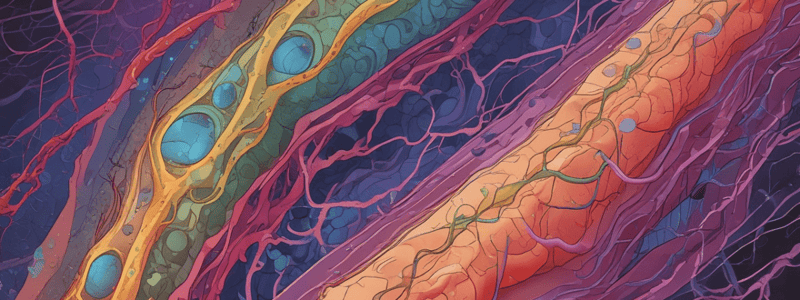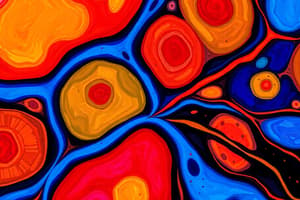Podcast
Questions and Answers
What is the primary function of tight junctions?
What is the primary function of tight junctions?
Where are desmosomes typically found?
Where are desmosomes typically found?
What is the purpose of gap junctions in cardiac muscle cells?
What is the purpose of gap junctions in cardiac muscle cells?
What type of cell junction allows for the flow of water and ions between cells?
What type of cell junction allows for the flow of water and ions between cells?
Signup and view all the answers
Which of the following is a characteristic of desmosomes?
Which of the following is a characteristic of desmosomes?
Signup and view all the answers
What is the main difference between tight junctions and desmosomes?
What is the main difference between tight junctions and desmosomes?
Signup and view all the answers
In which type of cell are gap junctions often found?
In which type of cell are gap junctions often found?
Signup and view all the answers
What do gap junctions resemble structurally?
What do gap junctions resemble structurally?
Signup and view all the answers
What is the main function of tight junctions?
What is the main function of tight junctions?
Signup and view all the answers
Where are tight junctions often found?
Where are tight junctions often found?
Signup and view all the answers
What is the purpose of desmosomes?
What is the purpose of desmosomes?
Signup and view all the answers
What is the main difference between tight junctions and desmosomes?
What is the main difference between tight junctions and desmosomes?
Signup and view all the answers
What would happen if the bladder did not have tight junctions?
What would happen if the bladder did not have tight junctions?
Signup and view all the answers
What is the function of tight junctions in the intestines?
What is the function of tight junctions in the intestines?
Signup and view all the answers
What do desmosomes attach to?
What do desmosomes attach to?
Signup and view all the answers
What type of molecules can pass through the gap between cells connected by desmosomes?
What type of molecules can pass through the gap between cells connected by desmosomes?
Signup and view all the answers
Study Notes
Cell Junctions
- Cell junctions connect cells to each other and often occur in epithelial tissue.
- There are three main types of cell junctions: tight junctions, desmosomes, and gap junctions.
Tight Junctions
- Tight junctions are like a glue that connects two cells together, forming a watertight seal.
- They block the passage of water, ions, and other molecules between cells, preventing exchange from both sides.
- Found in areas where water cannot leak, such as the bladder, intestines, and kidney.
Desmosomes
- Desmosomes are connections that hold two cells together, attaching to the cytoskeleton.
- They allow small molecules like water, ions, and other small molecules to flow between cells.
- Found in tissues that experience stress, offering space for stress relief, such as skin and intestines.
- Desmosomes are like spot welds, holding cells together while allowing limited flow.
Gap Junctions
- Gap junctions form a tunnel between two cells, allowing water, ions, and other molecules to flow through.
- Found in cells that spread action potential or use electrical coupling, such as cardiac muscle and neurons.
- Gap junctions enable the spread of action potential, allowing the heart to beat and neurons to function.
Studying That Suits You
Use AI to generate personalized quizzes and flashcards to suit your learning preferences.
Description
Learn about the three major types of cell junctions: tight junctions, desmosomes, and gap junctions, and their role in connecting cells in epithelial tissue.




